How real-time rates are revolutionizing quote management

Volatile shipment prices, increased demand for consumer goods, and more competition for space than ever are all making it more difficult for forwarders or importers to get pricing for a shipment (not to mention the added complexity of cargo ships with luxury cars catching alight).
The challenges the freight market is facing indicate a desperate technological need to rapidly and accurately provide guaranteed prices when moving cargo. This is key for more than just moving cargo – it’s critical in order to create and maintain trust between the shipper and freight forwarder.
We’ve seen this first hand on WebCargo – the world’s largest cargo eBooking platform. The need to help forwarders all the way to their customers was a trigger to develop a small but absolutely revolutionary feature – Dynamic Quoting – to counter these problems. This tool allows freight forwarders to send quotes to their customers using both static rates and dynamic real-time rates, giving the shipper the ability to choose and potentially secure eBookings instantly.
But first…what is eBooking?
Getting a quote for a shipment, up until now, meant spending hours calling or emailing airlines or agents, quoting routes and asking for an estimated price based on static rates. It could take days to receive a response, and that’s before negotiations had even started.
The eBooking tool gives access to the most up-to-date airline rates and is directly connected to the airlines’ systems. Airlines love it too, which is why over 30% of global airline capacity is online. We utilize a direct connection with the airline’s database, which sends real-time rates instantly back to the platform via an API connection.
This gives freight forwarders the ability to compare live rates from different airlines, select one that works best for them, lock in the price they see without any changes to it, and secure the booking all in one go, guaranteeing the shipment for their client. But how can live rates make the quoting process more efficient for freight forwarders and their clients?
How dynamic quoting introduces live booking to customers
Many freight forwarding companies still rely on static rates to quote to their customers, and it’s still a long way away to anticipate a complete move to quoting completely with real-time rates.
But even when forwarders use live rates, by the time the customer views and accepts the booking, the rates may have changed. This means forwarders need to pad rates to control for volatility. Dynamic quoting bridges the gap between real-time and static rates, while reducing the gap between actual market rates and what the customer gets.
Here’s the basic flow for a freight forwarder:
- Search for a rate using WebCargo’s quoting tool.
- Find a rate that shows there is a dynamic rate available and select it for your quote.
- Send the quote to your customer.
- Your customer picks the live rate with the day that works for them and secures their eBooking. This is the important part – whenever the customer opens the quote, they can regenerate a real-time quote, complete with the forwarder’s profit margin – then they can book it themselves.
- Track the progress of your eBooking within your WebCargo account.
And since the industry hasn’t left static rates behind, WebCargo can help do both.
When viewing the rate search results, static rates and, if available, an option to book with live rates will be shown with the real-time price. The freight forwarder can then choose to add their profit margin to each real-time rate, which, when sent to the shipper, will be included in the final price.
This is the important part. When a forwarder shares a dynamic quote with a customer, the shipper can then compare both live and static rates and decide which works for them. If they select a real-time rate, they can then secure the shipment themselves with no changes to the price they see.
The Expert View on Dynamic Cargo Quoting
Marga from our Product team and Wayne, our Enterprise Senior Business Development Manager, talked to us about how this tool helps combat problems that stem from price volatility, creates trust between freight forwarders and shippers, and how it’s going to affect the way freight forwarders move cargo in the future.
1. How do you see the dynamic quoting tool affecting the way customers book shipments?
Marga: Dynamic quoting allows freight forwarders to quote with real-time capacity rates while maintaining their profit margins.
These rates can then be offered to their customers, which allows the freight forwarder to secure the quote and for the shipper to make the booking at the same time. This reduces the required amount of time to provide a quote, submit it to their customers, and guarantees the booking against actual capacity. Freight forwarders will therefore save time, maintain their profits, and just become generally more efficient.
2. What drove the WebCargo product team to focus on dynamic quoting?
The dynamic quoting tool is aligned with our vision of digitizing the freight industry, bringing more transparency when viewing cargo rates, and streamlining processes.
Before the pandemic, the entire market worked solely on static rates, which meant the option of showing live rates wasn’t viable. During the pandemic, it was clear that the volatility of the static rate market was problematic.
With this in mind and the huge growth dynamic rates offer, more and more airlines started to turn to this dynamic rate and quoting model for eBookings. Our eBooking workflow was stable and had already been adopted easily by customers, so it made sense to go in that direction. It was also clear to us that the same reliability and efficiency that real-time pricing and booking providers for forwarders would be valued by shippers as well.
3. This seems complicated – what was the process of implementing and designing the tool?
We saw the potential in the tool after doing some user testing. Then, we analyzed our static quoting workflow and brainstormed with our UX (User Experience) and RD (Research and Development) teams in order to evaluate how could we provide a good experience to the user given our system capabilities.
We then prioritized the most necessary requirements and created the minimum viable product. The feature will, certainly, evolve in the near future and become even more intuitive.
4. When would sending a customer a dynamic quote make sense?
Wayne: There are a number of situations where it makes sense. It could be that the shipper is tech-savvy, and the forwarder has a solid, long-standing relationship with them. It could be beneficial for customers who ship large quantities regularly on specific trade lanes, and finally if issuing quotes to other forwarders (agents), again, with whom there is a long-standing relationship.
5. What is the ROI, how does it save time, and what are the benefits?
There are arguably no risks involved. Rates quoted to the customer with real-time rates are reserved the moment they are accepted by the airline, meaning no risk of a loss.
This also reduces back and forth quoting negotiations, giving shippers complete transparency over the final price and the ability to select a specific date and time slots. It saves time for everyone, preventing the shipper from excessive waiting times when trying to contact carriers by phone call or email to finalize the eBooking.
On the forwarder side, it also offers more transparency and instant access to space, which, for the forwarder, means higher win rates and more sales. Finally, it means more time for operators to focus on what matters – time spent solving problems, building customer relationships, and providing value to customers’ supply chains.
6. If customers are directly booking themselves, how does the freight forwarder maintain control of the booking process?
It’s vital that customers who are being quoted with live rates understand how it works and what the implications are to appropriately set expectations.
When a customer finalizes an eBooking using the dynamic quoting tool, the forwarder is always notified, and the eBooking is registered on their WebCargo account. This information can all be found within the My eBookings tab. Here they can maintain complete control and edit or cancel the eBooking if necessary.
The Bottom Line
By giving transparency about pricing, cutting time to book shipments and guaranteeing the price seen when quoting regardless of market volatility, this tool can really streamline the process of quoting and eBooking.
Ready to learn more? Request your free WebCargo account below. Sign up now



